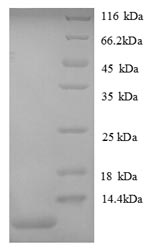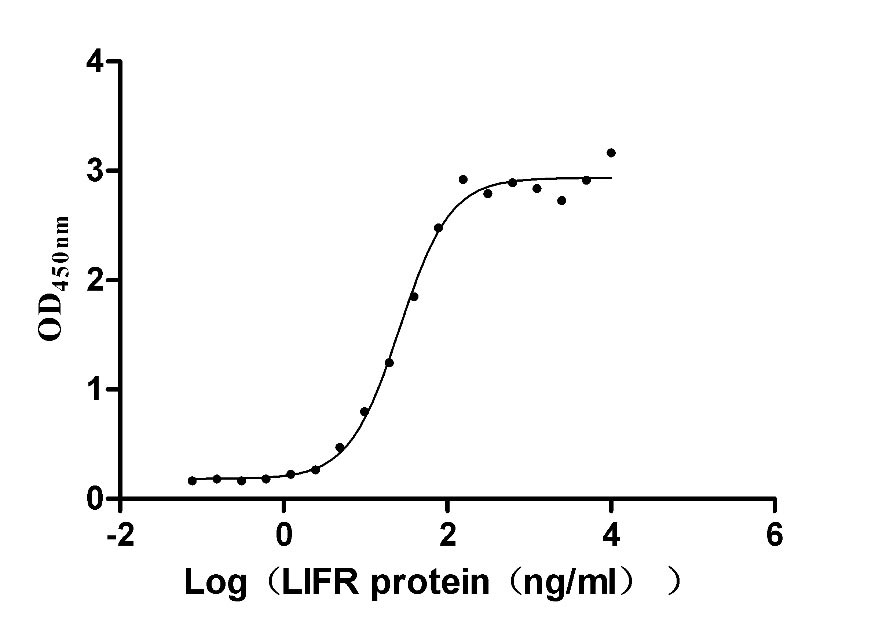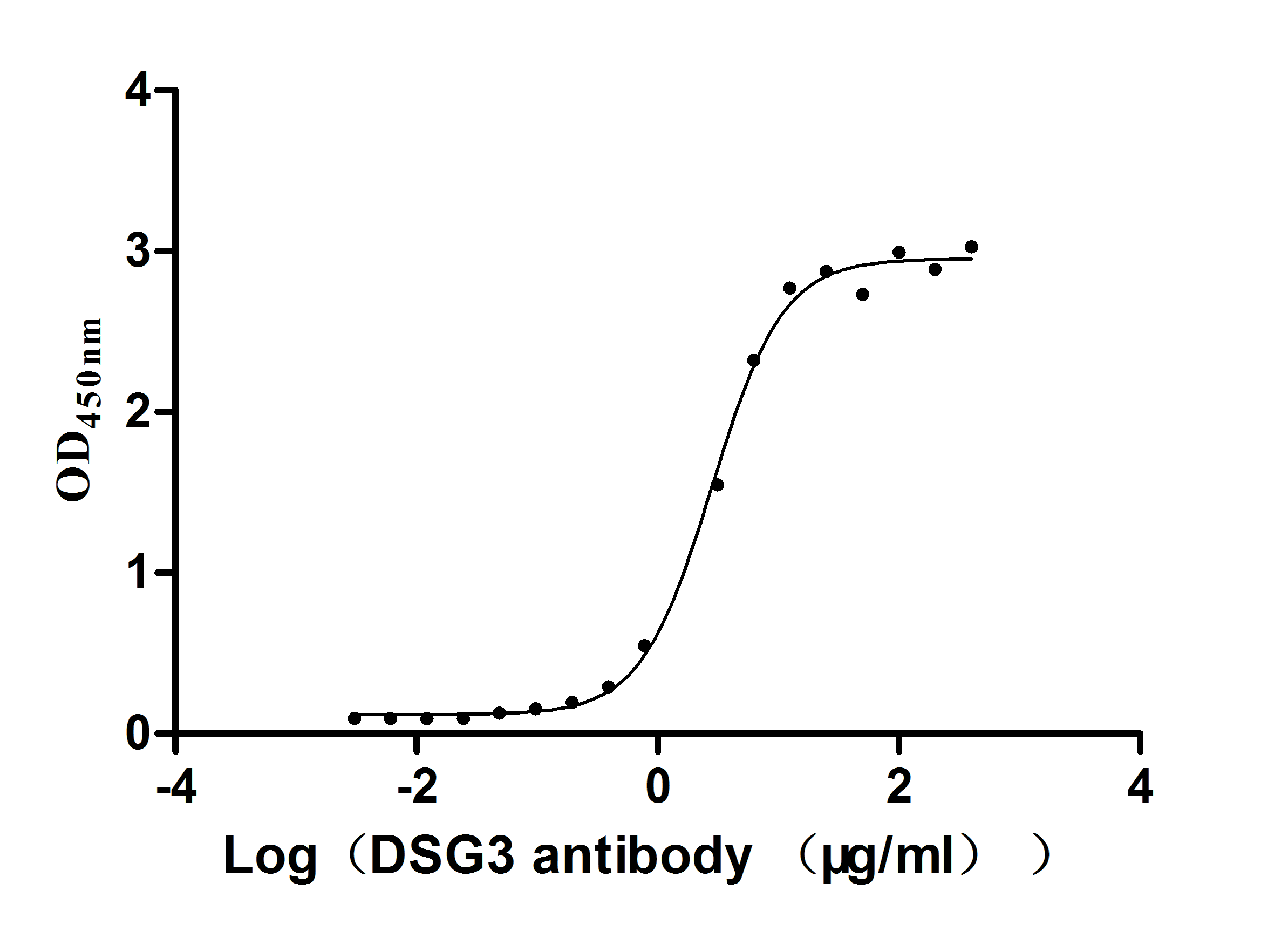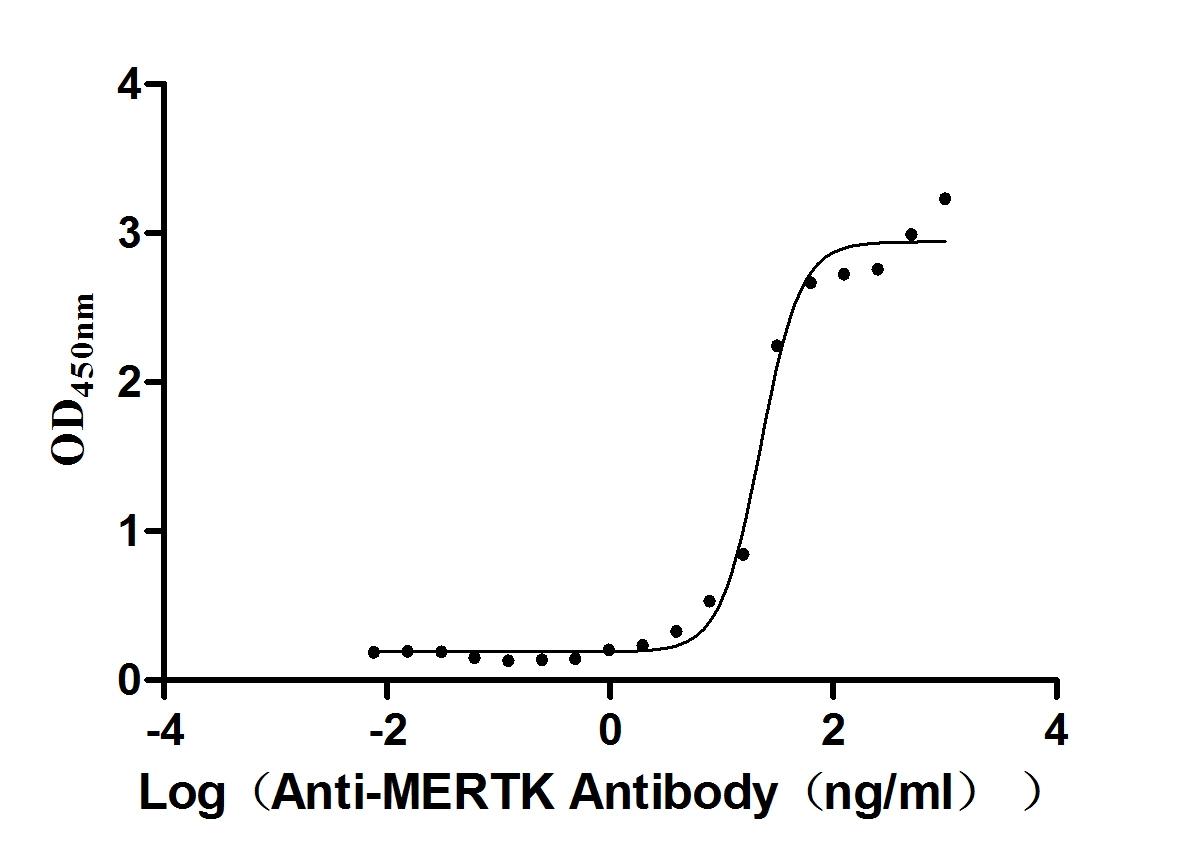Recombinant Mouse Growth-regulated alpha protein (Cxcl1), partial
-
货号:CSB-RP092174m
-
规格:¥1836
-
图片:
-
其他:
产品详情
-
纯度:Greater than 90% as determined by SDS-PAGE.
-
基因名:
-
Uniprot No.:
-
别名:Cxcl1; Gro; Gro1; Mgsa; Scyb1Growth-regulated alpha protein; C-X-C motif chemokine 1; Platelet-derived growth factor-inducible protein KC; Secretory protein N51) [Cleaved into: KC(5-72; Hematopoietic synergistic factor; HSF; KC-T)]
-
种属:Mus musculus (Mouse)
-
蛋白长度:Partial
-
来源:E.coli
-
分子量:11.5kDa
-
表达区域:29-96aa
-
氨基酸序列NELRCQCLQTMAGIHLKNIQSLKVLPSGPHCTQTEVIATLKNGREACLDPEAPLVQKIVQKMLKGVPK
Note: The complete sequence including tag sequence, target protein sequence and linker sequence could be provided upon request. -
蛋白标签:N-terminal 6xHis-tagged
-
产品提供形式:Liquid or Lyophilized powder
Note: We will preferentially ship the format that we have in stock, however, if you have any special requirement for the format, please remark your requirement when placing the order, we will prepare according to your demand. -
缓冲液:Tris-based buffer,50% glycerol
-
储存条件:Store at -20°C/-80°C upon receipt, aliquoting is necessary for mutiple use. Avoid repeated freeze-thaw cycles.
-
保质期:The shelf life is related to many factors, storage state, buffer ingredients, storage temperature and the stability of the protein itself.
Generally, the shelf life of liquid form is 6 months at -20°C/-80°C. The shelf life of lyophilized form is 12 months at -20°C/-80°C. -
货期:Basically, we can dispatch the products out in 1-3 working days after receiving your orders. Delivery time may differ from different purchasing way or location, please kindly consult your local distributors for specific delivery time.Note: All of our proteins are default shipped with normal blue ice packs, if you request to ship with dry ice, please communicate with us in advance and extra fees will be charged.
-
注意事项:Repeated freezing and thawing is not recommended. Store working aliquots at 4°C for up to one week.
-
Datasheet & COA:Please contact us to get it.
相关产品
靶点详情
-
功能:Has chemotactic activity for neutrophils. Contributes to neutrophil activation during inflammation. Hematoregulatory chemokine, which, in vitro, suppresses hematopoietic progenitor cell proliferation. KC(5-72) shows a highly enhanced hematopoietic activity.
-
基因功能参考文献:
- Data suggest that CD4+ T lymphocytes and microglial CD40 mediate their pro-nociceptive effects in part by promoting selected chemokine responses, and more importantly, CXCL1 can play an anti-nociceptive role in peripheral nerve injury-induced neuropathic pain, which is possibly mediated by infiltrating neutrophils. PMID: 29309879
- Adipose stromal cells recruitment to tumours, driven by CXCL1 and CXCL8, promotes prostate cancer progression. PMID: 27241286
- The results demonstrate that C57BL/6J mice have a functional defect in NLRP12, impaired CXCL1 production, and that macrophages require NLRP12 expression for effective recruitment of neutrophils to inflammatory sites. PMID: 27779193
- GAG interactions and receptor activity of CXCL1 monomers and dimers are fine-tuned to regulate neutrophil trafficking for successful resolution of tissue injury. PMID: 27625115
- a paracrine role for Hippo-mediated secretion of CXCL1 and CXCL2 in the production of anti-microbial peptides (beta-defensins), iNOS, NOX2 and pro-inflammatory molecules during mycobacterial infection of the host, is reported. PMID: 27883091
- this study demonstrates that in vivo blocking of CXCL1 and CXCL2 can significantly reduce the Mycobacterium tuberculosis-induced bioactive IL-1beta production PMID: 28739876
- CXCL1 contributed to rapid neutrophil recruitment during Bacillus cereus endophthalmitis. In CXCL1-knockout mice, retinal function was greater and neutrophil influx was less than in control mice, confirming its role in ocular inflammation. PMID: 27286792
- Interferon-gamma (IFN-gamma) up-regulated interleukin 6 (IL-6) and CXCL1 chemokine (CXCL1) production of bone marrow mesenchymal stem cells (mBM-MSC). PMID: 28791835
- Our work deciphers the mCXCL1-mTORC1 pathway as crucial in liver cancer stem cell maintenance PMID: 27488521
- MMP7 shedding of syndecan-1/CXCL1 complexes functions as a checkpoint that restricts neutrophil activation at sites of epithelial injury. PMID: 26934670
- Data show that loss of loss of matrix metalloproteinase-3 (MMP-3) repressed the upregulation of the chemokines monocyte chemoattractant protein (MCP)-1 and (C-X-C motif) ligand 1 (CXCL1). PMID: 27809288
- The novel findings reveal the critical role of NLRP12-IL-17A-CXCL1 axis in host defense by modulating neutrophil recruitment against Klebsiella pneumoniae. PMID: 26349659
- Nlrp12 deficiency caused increased neutrophil migration towards the chemokine CXCL1 and the neutrophil parasite Leishmania major, revealing NLRP12 as a negative regulator of directed neutrophil migration under these conditions. PMID: 26514298
- Chemotactic activity of stellate cell-derived CXCL1 was assayed in vitro on neutrophils upon TLR4 activation. PMID: 27002851
- IL-17RA regulates CXL-1 and 5 production in the lungs during the adaptive response. PMID: 26871571
- Data suggest that CXCL1/IL-8, released from osteoclasts in an autoantibody-dependent manner, produces pain by activating sensory neurons. PMID: 26613766
- TGF-beta negatively regulates CXCL1 expression in CAFs through Smad2/3 binding to the promoter, and through suppression of HGF/c-Met autocrine signaling PMID: 26252654
- work shows parallel networks of necroptosis-induced CXCL1 and Mincle signalling that promote macrophage-induced adaptive immune suppression and thereby enable pancreatic ductal adenocarcinoma progression PMID: 27049944
- Repeated social defeat-induced VCAM-1 protein expression were localized to the vasculature of brain regions implicated in fear and anxiety responses. PMID: 25445193
- In a chronic-binge ethanol-feeding model, the hepatic TLR2 and TLR9-dependent MyD88-dependent pathway mediates CXCL1 production, resulting in the development of alcohol-mediated liver injury. PMID: 25930080
- IL-1 signaling plays a pivotal role in activating mucosal stromal cells to secrete CXCL1 which is essential for infiltration of IL-22-secreting neutrophils upon Citrobacter rodentium infection. PMID: 26034212
- Zfp30 is expressed in airway epithelia in the normal mouse lung and Zfp30 expression in vitro affects CXCL1 responses to an immune stimulus. PMID: 25114278
- Metoprolol also decreased serum levels of proinflammatory cytokines TNFalpha and CXCL1 and macrophage content in the plaques, showing that metoprolol has an anti-inflammatory effect. PMID: 25105129
- This study demonstrated the role of peripheral CXCL1/CXCR2 signaling in postoperative pain in the setting of prior morphine exposure. PMID: 24887006
- phagocytosis of refrigerator-stored RBCs in vivo induced increases in circulating monocyte chemoattractant protein-1 (MCP-1) and keratinocyte chemoattractant (KC) PMID: 25041478
- Neutrophil recruitment and the neutrophil cytokines, CXCL1/CXCL2, were suppressed in apo(a)transgenic mice in the abdominal aortic aneurysm model. PMID: 24650562
- These data identify a cytokine circuit that involves IL-1beta-induced production of CXCL1 and CXCL2 and leads the recruitment of neutrophils to streptococcal infection sites. PMID: 25114117
- Estrogen receptors alpha regulates CCL20/CXCL1 secretion in the female reproductive tract. PMID: 23025258
- These studies suggest that modulation of CXCL1 levels in tissues and blood could reduce bacterial burden in sepsis. PMID: 25172493
- Pharmacological inhibition of NAMPT activity mitigates inflammation in atherosclerotic plaques by reducing CXCL1-mediated activities on neutrophils. PMID: 24196571
- Data indicate that levels of toll-like receptors TLR4/4-stimulated chemokines CXCL1 and CXCL2 were selectively enhanced in stressed macrophages via receptor-interacting protein kinase 1 (RIPK1). PMID: 24920846
- findings demonstrated that CXCL1 and CXCL5 are increased in circulation with onset of T2D, are produced by islets under stress, and synergistically affect islet function, suggesting that these chemokines participate in pathogenesis of T2D. PMID: 24928936
- In vitro, neutrophils adherent to ICAM-1 or ICAM-2 rapidly released TNF in response to LTB4, C5a, and KC. PMID: 24913232
- Secretion of Cxcl1 (KC) cytokine is inhibited by electrical stimulation in early and late experimentally induced arthritic spleen. PMID: 23791889
- A sustained form of CXCL1 upregulation is demonstrated that can drive neuropathic pain in the spinal cord. PMID: 23831863
- the presence of CXCL1 is required for recurrent Herpetic stromal keratitis as evidenced by the lack of corneal disease in mice treated with anti-CXCL1 Ab. PMID: 24442436
- CXCL1 expressed by monocytes and CXCR2 on HBMEC is involved in monocytes migrating from blood to brain in AD patients PMID: 23967336
- BCG-triggered increase of lipid body biogenesis was inhibited by the PPARgamma antagonist GW9662, but not by the NF-kappaB inhibitor JSH-23. In contrast, KC/CXCL1 production was largely dependent on NF-kappaB but not on PPARgamma PMID: 24120921
- IL-17 and TNF-alpha synergistically mediate CXCL1 production by ATII cells after ischemia/reperfusion, via an NADPH oxidase-dependent mechanism. PMID: 24186876
- excessive CXCL1 expression in gp130-deficient endothelial cells augments neutrophil adhesion but hinders migration, most likely by disrupting chemotactic gradients PMID: 24081661
- KC, a potent neutrophil chemoattractant and an established angiogenic factor, failed to interfere in the post-infarction inflammatory response, in wound healing and scar formation after MI. PMID: 23598282
- Molecular basis of glycosaminoglycan heparin binding to the chemokine CXCL1 dimer. PMID: 23864653
- Overexpression and distinct localization of LCN2, CXCL1 and CXCL9 in the liver of fatty liver Shionogi mice suggest significant roles of these proteins in the pathogenesis of non-alcoholic steatohepatitis. PMID: 23875831
- At day 10, CIP treatment not only significantly reduced pro-inflammatory cytokine and chemokine concentrations, including interleukin-6 (IL-6) and KC, but it also enhanced IL-3 production compared to vehicle-treated controls. PMID: 23520506
- In severe S. aureus bacteraemia in mice, TNF-alpha, IL-1alpha, and KC are biomarkers predicting fatal outcome of infection. PMID: 23520553
- the model that mast cells, optimally positioned in close proximity to the vasculature, initiate an early phase of neutrophil recruitment by releasing the chemoattractants CXCL1/CXCL2. PMID: 23645836
- When expressed, CXCL1 is limited to small areas with faint staining and PCa progression does not rely on CXCL1 expression. PMID: 23334998
- MMP9 expressed by intestinal epithelial cells mediates inflammation in colitis with simultaneous increase in proinflammatory cytokine Kc. PMID: 23471340
- Early systemic release of IL-6 and keratinocyte-derived chemokine Cxcl1 may not necessarily predict an unfavorable outcome in this model of stroke. PMID: 22533966
- Intrahepatic CXCL1 & circulating CXCL1 were strongly induced shortly after islet infusion. Blockade of the CXCL1-CXCR1/2 axis in mice improved intrahepatic islet engraftment. The CXCR1/2-mediated pathway is a regulator of islet damage. PMID: 22996693
收起更多
-
亚细胞定位:Secreted.
-
蛋白家族:Intercrine alpha (chemokine CxC) family
-
数据库链接:
KEGG: mmu:14825
STRING: 10090.ENSMUSP00000031327
UniGene: Mm.21013








-AC1.jpg)











